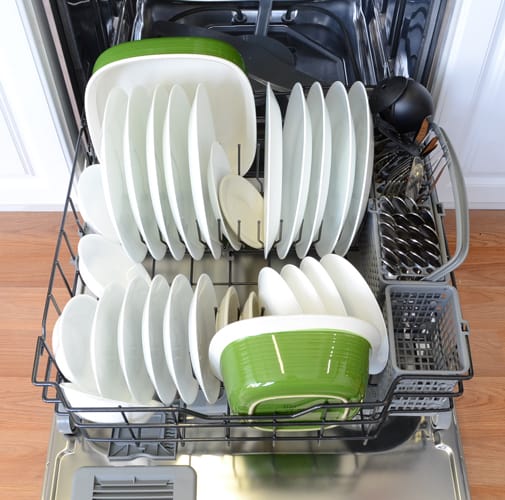Pros
Cons
Introduction
Front
{{section_header}}{{section.name}}{{/section_header}}

The front of the GE CDWT980VSS.
Finish
{{section_header}}{{section.name}}{{/section_header}}

Controls
{{section_header}}{{section.name}}{{/section_header}}


Interior
{{section_header}}{{section.name}}{{/section_header}}

The CDWT980VSS with door open.
Top Rack
{{section_header}}{{section.name}}{{/section_header}}

The top rack of the CDWT980VSS.
Bottom Rack
{{section_header}}{{section.name}}{{/section_header}}

The bottom rack of the CDWT980VSS.
Cutlery Basket
{{section_header}}{{section.name}}{{/section_header}}

The CDWT980VSS cutlery basket.
Electricity Use
{{section_header}}{{section.name}}{{/section_header}}
We found that this washer used quite a lot of electricity when it was in use, ranging from 0.32 kWh for the quick wash up to over 2 kWh for the Pots & pans cycle.
{{ attachments(50fc5208bd02867055000816)
Water Use
{{section_header}}{{section.name}}{{/section_header}}
The water use of this washer also varied a lot, from the 4.14 gallons of the Normal cycle to the 7.34 gallons used in the 1-Hour Wash.
Yearly Running Cost
{{section_header}}{{section.name}}{{/section_header}}
We calculate that this washer would cost about $36.29 a year to run, which is pretty average for washers of this size and type.
{{ attachments(50fc5208bd0286156c000817)
Washing Speed
{{section_header}}{{section.name}}{{/section_header}}
The {{product.name}} favors performance over speed, so the cycles are generally on the rather long side. The exception to this is the 1-Hour Wash, but as we shall see later, that had rather poor performance.
{{ attachments(50fc5208bd02867055000816)
Washing Performance
{{section_header}}{{section.name}}{{/section_header}}
We found a mixed bag of performance for this washer, with very good performance from the Normal and Pots & Pans wash cycle, but rather poor performance from the 1-Hour cycle.
{{ attachments(50fc5201bd028600af0007af)
Quick Wash Cycle
{{section_header}}{{section.name}}{{/section_header}}
The quick cycle had some problems with the heavily stained dishes we use in our testing, failing to shift some of the milk, tea, meat, egg and spinach stains. For all of these, at least one of our test dishes was not clean, with over half of our dishes still having visible traces of the stain remaining that would require rewashing. So, we would not recommend this cycle unless you have only very lightly stained dishes: anything heavier than a splash or two may not get clean.
{{ attachments(50fc5201bd028654550007b1)
Normal Wash Cycle
{{section_header}}{{section.name}}{{/section_header}}
The Normal cycle is the one for everyday mixed loads, and this had better performance, with much more of our test stains being removed. Here, we found that out meat stains were completely removed from our test plates, and there were only a few small stains remaining on many of our other dishes. But there were still a good number of dishes that would require rewashing: just under a third of the test load.
{{ attachments(50fc5201bd028654550007b1)
Heavy/Pots & Pans Wash Cycle
{{section_header}}{{section.name}}{{/section_header}}
The heavy cycle is where we really let the washer go: here, we use the cycle designed for cleaning pots and pans, and add a number of cooking dishes to our load with baked-on stains such as cheese and sugar. For the {{product.name}}, the cycle we used was the Pots & Pans cycle, and we found it did reasonably well, shifting the stains from most of our dishes. Some did remain, though: we found that there were still a couple of spots of baked-on sauce on our lasagna dish, and a few remaining traces of egg on our cutlery. It also failed to shift much of the lipstick that we put on the rim of our test cups.
Pots & Pans Cycle
{{ attachments(50fc5201bd028657cd0007b3)
Washing Cycles
{{section_header}}{{section.name}}{{/section_header}}
The {{product.name}} offers a rather limited selection of cycles, with no delicate wash or glassware cycles. This seems like an odd omission, but there are enough cycles for most users.
Customization
{{section_header}}{{section.name}}{{/section_header}}
There are no options for customizing the cycles: you cannot change the wash level or heating levels.

Additional Wash Options
{{section_header}}{{section.name}}{{/section_header}}
The only additional wash option on offer is to add a 4 hour delay. You can't change the length of this delay, nor can you add extra rinses, sanitize or any of the other options that some washers offer.

Capacity
{{section_header}}{{section.name}}{{/section_header}}
We found that {{product.name}} could hold a reasonable amount of dishes: 9 place settings in total. That's enough for a large dinner party or 2-3 days worth of dishes for an average family. We measure this using a standard set of dishes (dinner and salad plate, soup and desert bowl, cup and saucer, knife, fork, two spoons and a teaspoon), so those who don't use this many dishes per meal should be able to pack in a fair number of dishes.

Top Rack

Bottom Rack

Wash Arms & Filters
{{section_header}}{{section.name}}{{/section_header}}
The {{product.name}} has three main washing arms for jetting the water at the dishes: the lower arm, the TurboZone jets and the upper arm. The bottom arm is unusually shaped, with an additional arm on one end that rotates in a circle as the main arm spins, shooting water in a number of angles. The TurboZone jets fire water from the back of the washer to try and do a more effective cleaning job on heavily soiled dishes and pans, while the upper arm fires water up into the cups, glasses and dishes on the top rack. Both the top and bottom arms are curved, which allows more water jets to be fitted into the width of the arms.

The CDWT980VSS wash arms.

The DW 14140 upper wash arm

The CDWT980VSS filter.
Lower Dish Rack
{{section_header}}{{section.name}}{{/section_header}}
The bottom rack of this dishwasher is a large square frame covered in Nylon. None of the tines or racks are adjustable or removable, but they are spaced to allow for different sized plates and dishes. The cutlery holder is located on the right side of the rack. We found this dish rack was easy to slide in and out, both when empty and fully loaded.
The back of the lower rack is aligned with a number of water outlets designed for washing heavily soiled items, such as pans and casserole dishes with burnt-on food. Kenmore refers to this as the Turbo Zone. The entire rack can be removed by pulling it onto the door and lifting it.

The bottom rack of the CDWT980VSS.
Upper Dish Rack
{{section_header}}{{section.name}}{{/section_header}}
The upper dish rack is the same size and shape as the lower one, but has a different arrangement of tines. Two of these rows of tines can be folded down out of the way to allow for different sized dishes, but they cannot be removed. The entire rack can be removed by flipping two latches on the end of the rail that the wheels run on, which allows the wheels to slide off the end and the entire rack to be removed.
The height of the rack can also be adjusted using the same system, as there are two sets of wheels, which allows larger dishes and glasses to be put into the top row. The process of lowering and raising the rack is a little awkward, requiring the complete removal and replacement of the rack, which requires some co-ordination to ensure the wheels are properly placed on the rack.

The top rack of the CDWT980VSS.
Cutlery Holder
{{section_header}}{{section.name}}{{/section_header}}
The cutlery holder clips into the right side of the lower dish rack, and offers four compartments, each with a lid that can be used to hold the cutlery so the items are separated. These lids can be folded back or removed as required, but you cannot remove any of the compartments to make the cutlery holder smaller.

The CDWT980VSS cutlery basket.
Detergent Dispenser
{{section_header}}{{section.name}}{{/section_header}}
The detergent dispenser is a standard design with a flip-up lid and two compartments for the main wash and the pre-wash. There are two levels in the main wash section: half full for soft water or lightly soiled loads, and and full for hard water and heavily soiled loads.
Next to the detergent dispenser is the rinse aid dispenser, which has three settings for dispensing the rinse aid that makes the dishes easier to dry. This has three settings, and seems to hold a good amount of liquid, so it should not require refilling very often.

The CDWT980VSS detergent dispenser.
Ease of Use
{{section_header}}{{section.name}}{{/section_header}}
The {{product.name}} is a pretty easy to use dishwasher overall, which offers just a limited number of features. We found these to be easy to use, though, and the washer is easy to load and unload.
Controls
{{section_header}}{{section.name}}{{/section_header}}
The controls for this dishwasher are touch controls on the front of the door, with accompanying blue LEDs. On the left side are the cycle selectors, with the wash options in the middle and the start and cancel buttons and progress lights on the right. These touch controls are a little sensitive; it is possible to accidentally push the cancel button if you lean against the front of the washer.


Efficiency
{{section_header}}{{section.name}}{{/section_header}}
Though the {{product.name}} used a fair amount of electricity in our tests, it proved efficient overall, with an average yearly cost to run.
Washing Performance
{{section_header}}{{section.name}}{{/section_header}}
The {{product.name}} does an adequate job at cleaning dishes, but adequate isn't good enough in such a crowded marketplace. While wash cycles are relatively quick, they also don't do as good a job as we'd like to see. Lipstick and spinach stains remained even after the heavy-duty pots and pans wash, and we certainly wouldn't eat off dishes that just went through the Kenmore's subpar quick wash.
Features
{{section_header}}{{section.name}}{{/section_header}}
Though there are enough cycles for everyday dish cleaning, a delicates/glassware cycle is curiously missing, and you can forget about creating your own custom wash cycle. The {{product.name}} was easy to load and unload, but nine place settings were a tight squeeze.
Meet the tester
Richard Baguley is a veteran writer who has written about technology ranging from Alphabet to Zip file utilities. He has contributed to pretty much every major tech publication, including Amiga Format Magazine, PC World, Wired, CNET, Toms Guide, Forbes, and many others. He lives in the Boston metro area with his wife, dog, and an indeterminate number of cats.
Checking our work.
Our team is here to help you buy the best stuff and love what you own. Our writers, editors, and experts obsess over the products we cover to make sure you're confident and satisfied. Have a different opinion about something we recommend? Email us and we'll compare notes.
Shoot us an email

